Teamsheet from the first ever game at The Hawthorns, Albion v Derby County, September 3, 1900
Five days after the ground's initial game, a new attendance record of 35,417 is set with the visit of Aston Villa.
1901 Just 1,050 fans turn up for the First Division match between Albion and Sheffield United on the last day of the season. The attendance is the lowest crowd to ever assemble for a first team game at The Hawthorns.
1902 The ground hosts the FA Cup semi-final between Derby County and Sheffield United. A crowd of 33,603 watch a 1-1 draw between the two sides.
1904 The 'Noah's Ark' stand which had been transferred from Stoney Lane burnt down on Bonfire Night. The official cause of the fire is unknown but a stray firework, or a discarded match or cigar dropped at the game against Manchester United earlier in the day, is reportedly the most likely cause.
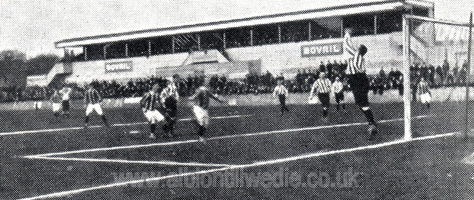
The 'Noah's Ark' Stand 1904
1905 A half-time scoreboard is installed at the ground for the first time. It is located at the Birmingham Road End.
1906 A new stand is constructed at the Smethwick End.
1907 The ground's previous record attendance is broken when 35,529 watch the FA Cup tie with Derby County in February.
1908 A new record attendance of 36,727 is set in January for the visit of Birmingham in the FA Cup. The record is broken again in December when 38,049 turn up to watch the league game between the same two teams.
A two day athletics meeting is held at the ground in May.
1910 The lease of the ground is extended for another eleven years.
1911 The league game with Aston Villa in September attracts the first 40,000 plus gate (46,203) to the stadium creating a new attendance record.
Improvements are made to the Halfords Lane Stand.
1912 A stand is erected over the Handsworth side, paid for with the club's share of prize money from the 1912 FA Cup final.
The pitch is dug up and completely relaid.
1913 The freehold of The Hawthorns is purchased for £5,350.
A new record attendance of 48,057 is set in October. Aston Villa are once again the visitors.
A two day boxing tournament takes place at the ground.
1914 The Halfords Lane Stand is extended and tip up seats are installed.
The Football League take on the Irish League in a representative match at the ground.
1919 Wolverhampton Wanderers play two 'home' league games at The Hawthorns (versus Barnsley and Stockport County) after Molineux is closed following crowd disturbances.
1920 The wooden fence surrounding the playing area is replaced with a concrete wall and the first sections of terracing are constructed.
England and The South meet in a representative match at The Hawthorns.
1921 On Boxing Day, 49,488 spectators watch the local derby with Birmingham, a new crowd record.
1922 England beat Ireland 2-0 in the first full international match to be staged at The Hawthorns.
Two sets of turnstiles are incorporated into the Birmingham Road End.
1923 The embankment on the Handsworth side of the ground is extended further back and the stand also heightened.
The first 50,000-plus crowd assemble at The Hawthorns when 56,474 fans watch the FA Cup 2nd round tie with Sunderland.
1924 In the second full international game to be played at the ground England beat Belgium 4-0.
A new block of turnstiles are built at the Smethwick End / Halfords Lane corner.
1925 A new ground attendance record of 64,612 is set with the visit of Aston Villa in the FA Cup 3rd round.
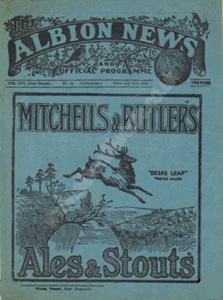
Programme for the FA Cup match against Aston Villa in 1925
1928 England beat The Rest 6-3 in the third major representative game to take place at the ground.
1931 The Hawthorns Halt railway station is opened on Christmas Day.
A then record league gate of 52,415 attend the final game of the 1930/31 season against Charlton Athletic. The game sees Albion clinch promotion back into the First Division and complete the historic promotion / FA Cup double.
1932 A new scoreboard is installed at the corner of the Handsworth Stand / Smethwick End. The old one had stood at the back of the Birmingham Road End terrace.
1934 A new stand is built at the Smethwick End / Halfords Lane corner which increases the capacity of the ground by an extra 750 seats.
A record crowd for a reserve game of 22,372 is set for the visit of Aston Villa in the Central League.
1935 England once again take on The Rest in a representative match at The Hawthorns, the game ending all square at 2-2.
1937 The present day record attendance of 64,815 is set for the FA Cup quarter final tie versus Arsenal on 6 March.
1939 The wooden roof of the Halfords Lane stand is replaced by asbestos sheeting.
1940 All major work at the ground is halted owing to World War 2.
1944 A baseball game between the US Army and Canadian Army takes place in front of 5,000 spectators.
1945 Loud speakers are installed at the ground.
England lose 1-0 to Wales in a Victory International in front of a crowd of 54,610.
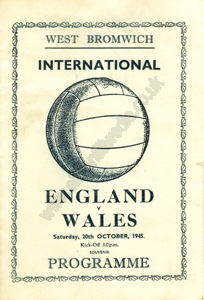
'Pirate' Programme for the Victory International between England and Wales in 1945
1947 A new block of twelve turnstiles open on the Handsworth side of ground.
1949 The first electronic turnstile aggregator to be used in a British football ground is installed at The Hawthorns.
The front of the Halfords Lane Stand is extended to give a further 750 seats. The old wooden 'terraces' at the front of the stand are replaced with concrete.
1950 The present day record league attendance of 60,945 is set for a First Division game against Wolverhampton Wanderers.
The Hawthorns celebrates its Golden Jubilee.
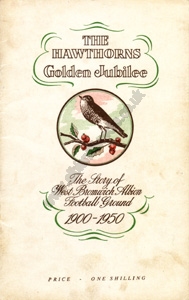
Booklet issued to celebrate The Hawthorns' Golden Jubilee
1951 Eight new turnstiles are opened at the Smethwick End.
1954 The last 60,000-plus attendance at the ground assembles for the FA Cup game with Newcastle United. 61,088 fans turn up to watch Albion - the eventual cup winners - progress to the quarter finals with a 3-2 victory.
1956 The scoreboard is moved to the Woodman Corner, where it would remain until demolition in 1994.
1957 Floodlights are installed at a cost of £18,000. The first game under the lights sees Albion and Chelsea play out a 1-1 draw on September 18. The official opening of the lights takes place on October 29 when the Russian Red Army Team (CDSA) are beaten 6-5 in a friendly game held before a crowd of 52,805.
1958 A new wing is added to the Halfords Lane Stand at the Birmingham Road End corner which increases the capacity by an extra 1,200 seats.
1960 The FA Cup semi-final between Aston Villa and Wolverhampton Wanderers takes place at The Hawthorns in front of a crowd of 55,596.
1962 The last 50,000-plus attendance (54,992) at the ground assembles for the FA Cup game against Tottenham Hotspur in February.
1964 The original East Stand, containing 4,300 seats, is built at a cost of £40,000. The new stand reduces the overall capacity of the stadium to around 50,000. The stand would become known as the Rainbow Stand. The roof off the old stand is transferred to cover the Birmingham Road End.
1965 A crowd of 41,188 watch the League Cup round 2 clash with Walsall. The attendance is Albion's record home gate for the competition.
The first Throstle Club, located next to The Hawthorns behind the Rainbow Stand, is officially opened by Graham Williams and Jesse Pennington.
The Hawthorns hosts the FA Amateur Cup semi-final between Hendon and Skelmersdale.
1968 The Hawthorns Halt Railway Station closes.
The Football League Cup semi-final replay between Burnley and Swindon takes place at the ground.
1969 The club holds it's first ever Open Day for the fans. Over 6,000 attend.
1970 Floodlighting at the ground is upgraded for colour television.
Walsall use The Hawthorns as their home venue for the league game against Brighton because of waterlogging at Fellows Park.
1971 The Hawthorns plays host to the FA Trophy semi-final between Telford United and Yeovil Town.
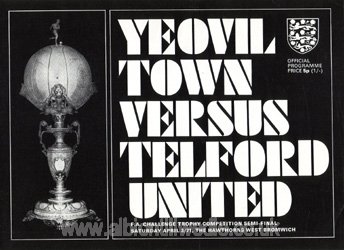
Programme for the FA Trophy semi-final replay between Yeovil Town and Telford United, April 3, 1971
1976 Fourteen executive boxes are installed into the Rainbow Stand. A further 1,600 seats are installed in front of the boxes taking the overall seating capacity of the ground to 12,500.
1977 New crush barriers are erected and the terraces are reconstructed at the Smethwick and Birmingham Road ends of the ground.
An Indian X1 and Pakistan X1 clash in the first cricket game to take place at the stadium. All proceeds from the limited overs match go towards a children's charity and Imran Khan's benefit.
1980 Work starts on a new Halfords Lane Stand.
A Warwickshire X1 take on an Ian Botham X1 in a 30 overs a side floodlit cricket match at The Hawthorns. The proceeds go towards Ally Robertson's testimonial fund.
1981 The Halfords Lane stand is completed at a cost of £2.5million.
1983 The Hawthorns Throstle Club is closed down.
An electronic scoreboard is added onto the front of the Smethwick End roof.
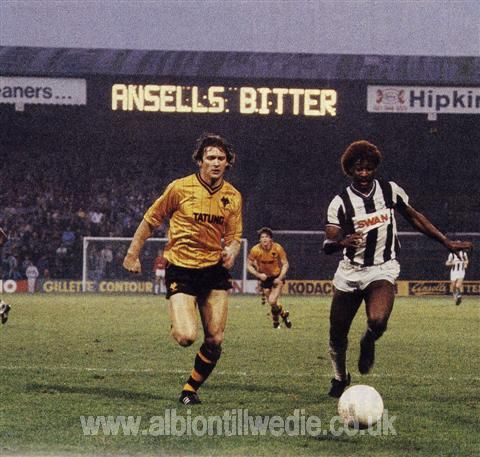
The Smethwick End electronic scoreboard, 1983
1985 The Smethwick End roof is replaced and the electronic scoreboard removed.
1987 The FA Trophy Final replay between Burton Albion and Kidderminster Harriers is held at the ground.
1988 For the second successive season, The Hawthorns plays host to the FA Trophy Final replay. Enfield and Telford are the finalists.
1989 A new sponsors lounge is opened in the Halfords Lane / Birmingham Road End corner.
1990 The pitch is completely dug up and relaid for only the second time in the club's history. Supporters get the chance to buy sections of the old pitch at a cost of £3.95 per square foot. Over 1,000 fans take up the offer.
1991 The FA Cup 2nd round tie at Leyton Orient is shown live on a big screen at The Hawthorns.
1992 The Smethwick End roof is removed.

The Smethwick End, Open Day 1992
1994 The Smethwick End terrace is used for the very last time in a League Division One game against Luton Town on New Year's Day.
The Birmingham Road End and Woodman Corner terraces are used for the last time on April 30 for the League Division One game against Grimsby Town. The end of the game sees a number of fans taking home their own mementos of the soon to be demolished terraces, including the throstle off the top of the Woodman Corner scoreboard. After an appeal the throstle is returned to the club.

Postcard issued by Xtra Am radio station
Work starts on turning The Hawthorns into an all-seater stadium, the new Smethwick End Stand is completed first in September followed by the new Birmingham Road End Stand in December.
The pitch is dug up and relaid for the third time.
1995 The last remaining section of terracing, located in the Rainbow Stand / Smethwick End corner, is used at the ground for the last ever time for the FA Cup tie with Coventry City on January 18.
The Hawthorns railway station is reopened.
The Albion museum, located in the Halfords Lane Stand, is officially opened by manager Alan Buckley.
1997 The FA Cup 3rd round tie at Chelsea is beamed back live to a big screen at The Hawthorns.
Record ground receipts of £264,167 are taken from the League Cup game with Liverpool in October. It is the first time the £250,000 mark is broken.
1998 The Hawthorns pitch is dug up and relaid for the fourth time with undersoil heating also installed.
In February, The Hawthorns hosts the 'B' International game between England and Chile whilst in April the ground hosts a women's international between England and Italy.
2000 The Hawthorns celebrates its centenary in September.

